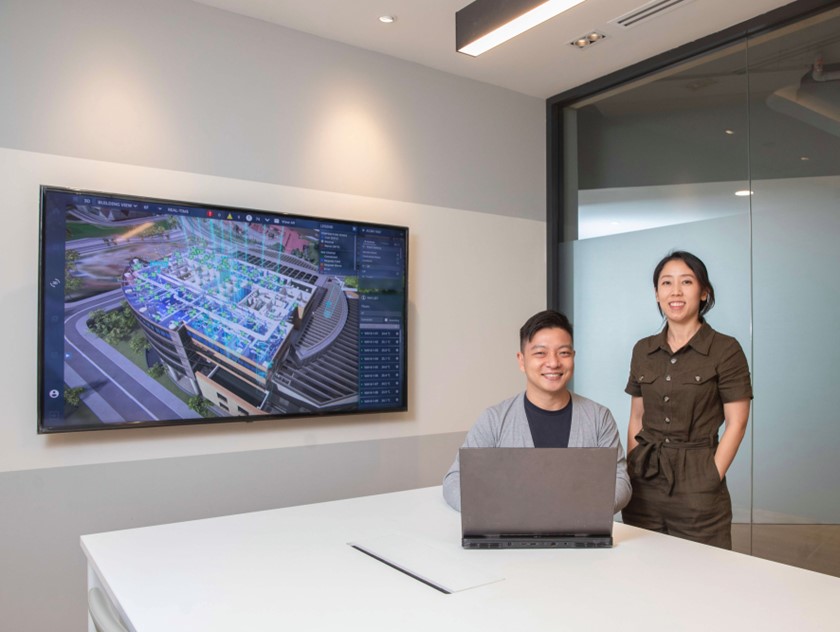
Punggol Digital District isn’t just any estate or business park. When completed, it’s where new innovations, testing of ideas, and sharing of data help drive Singapore’s digital sectors — as well as its Smart Nation endeavours — forward.
The Open Digital Platform (ODP) is the key that makes these possible. Developed by JTC, GovTech, and ST Engineering, it is a digital infrastructure unique to PDD. The ODP brings together various systems enabling not just the optimisation of building management and resources, but also makes PDD a “living lab” for experimentation and innovation.
Why the ODP makes PDD a one-of-a-kind digital district
To enable smart services and integrated operations, these systems would have to communicate with each other. However, this poses a problem, according to Mr James Tan, Director of JTC’s Smart District Division. “Smart city technologies, such as autonomous vehicles, lifts or the district cooling systems, operate in their own protocols, or ‘language’. They cannot communicate directly with each other,” he explains. “So, while you may be able to walk into a building and gain instant access as the facial security system recognises you, it is unable to instruct the lift to automatically pick you and send you to your destination floor because these two systems do not understand each other.”
Enter the ODP, which is being developed by Mr Tan and his team of young, budding engineers from JTC’s Smart District Division.
The key ingredient to the ODP is its Open Standard Multiprotocol Middleware, which will be able to connect different district management systems on different communications technologies. “In essence, we are designing the Open Standard Multiprotocol Middleware as the ‘master language translator’ of the estate,” says Mr Tan. “Our job is to integrate all these systems by making them understand each other.”

A new dimension to test-bedding
Besides the Open Standard Multiprotocol Middleware, the ODP also has a second crucial capability — its digital twin.
This digital twin, based on the real-life 3D model of PDD, represents an exciting development for digital firms. “With the amount of district data collected through various sensors such as temperature and the weather, power consumption, and the number of people in the district, we get an unparalleled opportunity to create an extraordinary digital twin,” explains Mr Dias Leong, a 3D modeller and a member of the JTC ODP team. “This allows real-world systems, even robots, to be accurately and timely represented in the digital realm, thus enabling monitoring and control.”
Because the digital twin is a replica of PDD, technology firms looking to test-bed their solutions have the freedom to plug directly into the digital twin and experiment without worrying about compromising either their solutions or the district. They can also use its event simulations and historical playback functions to test solutions. Thus, companies can get real-world results from simulations without the risks usually involved with test-bedding ideas.
“Users are able to inject scenarios to simulate events to improve district operations in the future, such as optimising cooling and lighting requirements during different times of the day, and much more,” shares Mr Tan. “As a part of the Punggol community, JTC is making our building data available to innovators, particularly companies in PDD and students at the Singapore Institute of Technology. With the data, these bright minds can develop new products and services. This will make Punggol an economically competitive estate for businesses and start-ups.”
A sustainable district, powered by the ODP
With the ODP, JTC envisions a new way of operating future estates like PDD.
At the upcoming district, the ODP recognises the added human traffic on a crowded day and automatically increases both cleaning services and cooling levels at the specific area where more footfall is encountered. When there’s no one around, the system shuts off a building’s lights, water coolers, air conditioners, and other unnecessary energy expenditure. This contrasts with the traditional way of doing things, where facility managers would have to spend time manually adjusting the systems based on the best available information or CCTV footage since there is little to no integration.
“The ODP will make PDD and Punggol a tech-enabled smart and sustainable district,” says Mr Tan, who intends to add artificial intelligence (AI) and machine learning capabilities to the system. “We’re working towards achieving the very ambitious target we’ve given ourselves – 30% energy savings in PDD compared to standard buildings.”
Because of its capacity to collect data through sensors and individual systems across the estate, the ODP can accurately predict energy demand and supply, which further helps the district with its energy maximisation efforts. “The data from these disparate systems will be fed into the machine learning models of the ODP. For example, it will be able to adjust air-conditioning output automatically and save energy without compromising user comfort,” shares Miss Shermaine Wong, a JTC data scientist working on the ODP.
First stop, PDD. Next stop? The rest of Singapore
But the powers of AI and machine learning don’t just stop there. As robots and autonomous goods delivery become more prevalent in the future, JTC plans to use the ODP as the “traffic controllers” for robots within an estate.
“When robots encounter each other, how do you assign which goes into the lift or gantry first? What if a corridor is a dead end?” says Mr Tan. “We’re giving the ODP marshalling capabilities so that robots from different robotic fleet systems can operate smoothly within the estate once they’re integrated with the ODP.”
On future expansion plans of the ODP beyond PDD, Mr Tan is hopeful: “We believe that the ODP can go to other estates in Singapore. With the ODP, we can help bring about smart services and products to the rest of the nation. Who knows? The ODP could be right at your doorstep.”

